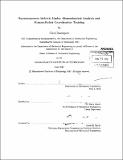Supernumerary robotic limbs : biomechanical analysis and human-robot coordination Training
Author(s)
Davenport, Clark (Clark Michael)
DownloadFull printable version (8.569Mb)
Other Contributors
Massachusetts Institute of Technology. Department of Mechanical Engineering.
Advisor
H. Harry Asada.
Terms of use
Metadata
Show full item recordAbstract
As the workforce within manufacturing grows older, especially within aircraft manufacturing, the need for new technologies to assist workers arises. If a technology could offer improvements to an aircraft manufacturing laborer's efficiency, as well as reduce the load on his body, it could potentially see vast use. This thesis discusses a potential solution to these issues - the Supernumerary Robotic Limbs (SRL). These limbs could potentially increase the workspace of the human operator to him more efficient, as well as reduce the load on the human while he performs staining tasks. It accomplishes this by providing the worker with extra arms in the form of a wearable backpack. This thesis first evaluates how the torques imposed on a human are affected when he uses an SRL-like device to help bear a static load. It is shown that the human work load necessary to bear such a load is reduced substantially. The second focus of this thesis is the skill acquisition. A data-driven approach is taken to learn trajectories and a leader-follower coordination relationship. This is done by generating teaching data representing trajectories and coordination information with two humans, then transferring the pertinent information to a robot that assumes the role of the follower. This coordination is validated in a simple one-dimension example, and is implemented on a robot that coordinates with a human leader during a control-box wiring task.
Description
Thesis (S.M.)--Massachusetts Institute of Technology, Dept. of Mechanical Engineering, 2013. Cataloged from PDF version of thesis. Includes bibliographical references (p. 83-86).
Date issued
2013Department
Massachusetts Institute of Technology. Department of Mechanical EngineeringPublisher
Massachusetts Institute of Technology
Keywords
Mechanical Engineering.